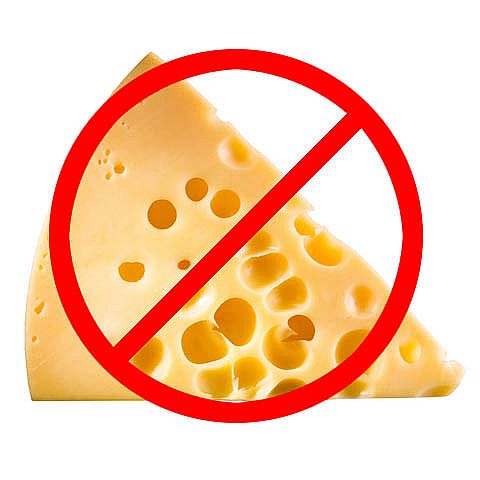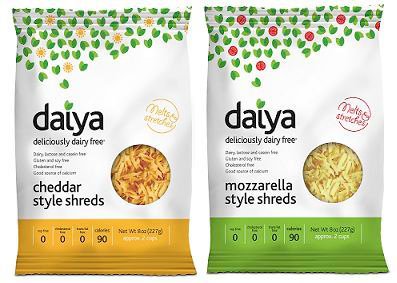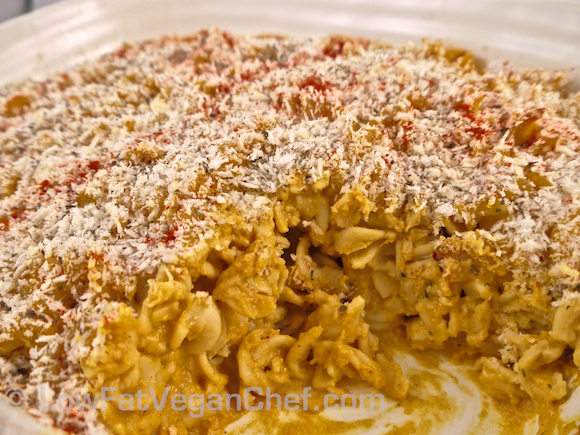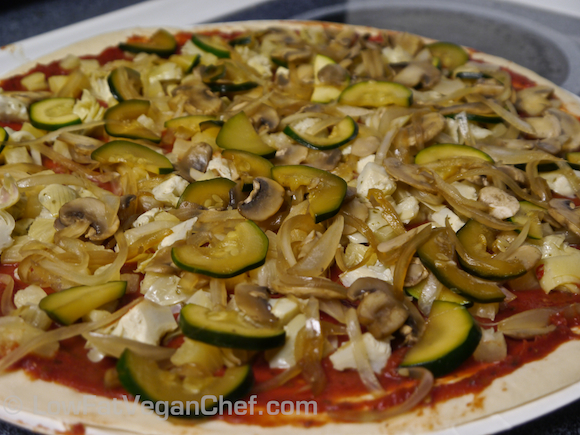Cheese might be the #1 food that prevents many vegetarians and omnivores from believing they could eat vegan, let alone be happy eating that way.
So if you feel upset or frustrated at the thought of not eating cheese regularly, don’t worry you’re not alone.
Cheese is naturally highly addictive to humans because it’s both fatty and very salty and contains casein (a dairy protein that has been shown in studies to be as addictive as opiates believe it or not).
The combination of these factors makes it extremely hard for anyone to willingly give it up cold-turkey.
But let’s say you already know that cheese and dairy products aren’t good for you because you’ve read books like The China Study or seen the film Forks Over Knives.
How do you make meals taste good without cheese?
Option #1: Substitute Vegan Cheese
Depending where you are on your vegan journey you could switch to a vegan cheese for starters such as Daiya Vegan Cheese. I don’t often use it, only very occasionally as it still contains oil and is high in fat, but it may be helpful to make a plant based transition for you or family members who need a little sprinkling of something for certain recipes. Please go easy on adding vegan cheese, it tastes quite rich and you don’t need as much as you normally would with regular cheese. All cheese and cheese-like foods are made with oil and are high in fat, it is not health food.
Option #2: Make Faux Cheese At Home
Another option is to use a mixture of crumbled tofu with miso paste and nutritional yeast to create a sort of tofu ricotta mixture that is tangy and feels
creamy like regular ricotta. (I show you how to do this for Plant Based Lasagna in my Comfort Soups From Around The World recipe ebook.
If you are looking for a creamier cheese to drizzle you can try using cashews and blend it with some water, garlic, lemon, miso paste, nutritional yeast and liquid sweetener to create a nut cheese. There’s even a whole book about making faux cheese called The Ultimate Uncheese Cookbook!
For low fat cheese sauces check out my Comfort Foods ebook again for cheezy sauce for vegetables or mac & cheese recipes.
http://www.plantbasedu.com/comfortfoods
Option #3: Go Without and Use Other Seasonings
Eventually you want to be able to enjoy healthful foods without resorting to cheese like toppings (because they are often high in salt and fat).
I recommend using more veggies and adding fresh herbs and more seasonings to make recipes taste delicious without added cheese.
For example, for pizza roast or sauté veggies in different seasonings and load up a healthy pizza crust with lots of pizza sauce and a variety of veggies. I often like to add sautéed mushrooms, sautéed zucchini, sautéed onions, wilted spinach, fresh basic, fresh garlic, red onions, pineapple, artichokes (packed in water), peppers etc. If you want something creamy on top you can take thin slices of avocado and put it on top of the pizza after it’s cooked for that creamy texture.
For pasta sauces I like to use fresh garlic, basil and onions to kick up the flavor to canned tomatoes or bottled sauce and cook it and blend it together so it has more flavor. If your sauce is tasty you won’t need cheese for that tangy salty flavor.
While your cheese cravings won’t likely disappear overnight, please know that they will greatly diminish as you start eating less and less of it and trying new
foods.
Also you should know that your tastebuds regenerate every 10-14 days! So you can train your tastebuds to want other foods instead of cheese by eating them instead.
Just like any other addiction, the more you have it the more you want it. So try to gradually reduce your cheese and dairy consumption until you no longer think about it.
Once you are accustomed to eating a low fat, oil free diet even vegan cheese can lose its appeal and seem like nothing more than salty oily goo. I quite enjoy eating
homemade vegan pizza as more of a flatbread topped with lots of veggies and find it doesn’t need anything else.
For tasty plant based meals that don’t require any fake meat or fake cheese check out my ebook
Comfort Foods From Around The World
And learn how to make a healthy version of your old favourites using things like nutritional yeast, miso paste, squash and tofu instead for that creamy cheese like flavor.
I hope I’ve given you some helpful tips on how to banish those cheese cravings. Just take it one day at a time and soon cheese will be in your rearview mirror and you won’t even be missing it at all.







Having had a gynecological cancer, I asked several doctors and natural practitioners about the soy-hormone connection and whether I should avoid the stuff.
The consensus seems to be that, if you’re drinking soy milk by the quart, eating edamame and tofu in large amounts at every meal, and using soy condiments and snack foods every single day, maybe cutting back would be a good idea. But the reasons to cut back would have more to do with single-sourcing protein intake and possible over-consumption of protein, more than the hormonal thing.
Basically, you’d have to eat more than you’d want to in order for the hormone thing to affect you negatively. EXCEPT IF you’ve been diagnosed with hypothyroidism and/or are taking thyroid medication. If so, have that discussion with your own doctor because soy is believed to interfere with the absorption of the drug.
Otherwise, avoiding chlorine makes much more sense (women in areas where water is treated with chlorine have been found to have higher cholesterol levels, and chlorine absorption inhibits thyroid hormone production) than worrying about eating soy every day of the week.
We can do many other things in our daily lives to avoid hormonal imbalances (avoiding phthalates in cosmetics, as well as avoiding pesticides, BPA plastics, and other hormone disruptors) rather than cutting out a healthy source of protein for vegans!
Interesting post – and definitely relevant for all vegans! You include some great options here.
I personally do not miss cheese at all – even though I used to love it in huge quantities (I was a serious addict) – but I’m keeping these tips up my sleeve in case I come across anyone finding the transition difficult.
I have a question about soy (specifically tofu) – I try not to eat it too often because I’ve heard it can mess around with your hormones. Is this true? Right now, I eat it about 2 times a week and I’ve switched to using almond milk instead of soy milk. I’ve been making my own cheese using cashews so I don’t eat too much soy. Am I being a little ocd? I’m trying to lose a substantial amount of weight and I’ve been doing the Eat to Live diet for 2 weeks now, but I’ve been gluten and dairy free for a year now, and an on again/off again vegetarian. This is the first time I’ve done a vegan diet, so I’m trying to make sure I keep up with my protein. I eat lots of beans, but soy seems to be a big shot of protein. Anyway, thanks for your website. I’m going to try out your zucchini ranch dip tomorrow. (sorry I’m rambling). Thanks in advance for your response.
Hi Heather
I don’t personally worry about tofu. Perhaps if someone had a hormonal disorder they should look into it along with their doctor, but for most people that is not the case.
Here’s some articles about soy: http://zenhabits.net/soy/ http://www.solae.com/Soy-Markets/Sports-Nutrition/Know-the-Truth-About-Increased-Soy-Intake.aspx
Are you allergic to wheat or a diagnosed celiac? I find a lot of people are unnecessarily on a gluten free diet because of confusion in the natural health world. I’m going to do an article or something later on about this. Most gluten free food is unhealthy and highly processed and contains a lot of fat, so unless someone has celiac disease or a wheat allergy I don’t think you should be on a gluten free diet “just because”. Avoiding gluten and grains and eating other whole plant foods instead is fine, but avoiding gluten to eat processed packaged gluten free items isn’t.
Hope that gives you some information.
Great post that I know most vegetarians would love! Thanks for sharing!